Recently updated on October 2nd, 2025 at 11:01 pm
As the late great chef Anthony Bourdain once said, Mexican food is, “not simple, or easy. It is in fact, old – older even than the great cuisines of Europe – and often deeply complex, refined, subtle, and sophisticated”.
Taste your way around Mexico and you’ll see this delectable ‘complexity’ stems from a rich cultural heritage, where ancient Indigenous knowledge, Spanish colonial influences and regional customs blend into something far more moreish than the sum of their parts. This culinary diversity plays out across deserts in the north, tropical rainforests in the south, the volcanic heartlands of the central plateau, and more than 11,000km of coastline (use this handy map to get your bearings).
With 35 UNESCO World Heritage Sites, 67 national parks, ancient pyramids like Teotihuacán, sacred cenotes, and buzzing centres like Mexico City, Guadalajara and Mérida, this land is a true multisensory feast – and wherever your tastebuds lead you, you’ll find all manner of nosh spots, from lively cantinas to coastal palapas and Michelin-starred kitchens.
Time-honoured ingredients – like corn, beans, chillies and fresh herbs – are at the heart of it all, along with centuries-old techniques like nixtamalization (soaking and grinding maize into masa, the base for tortillas and tamales), slow-cooking in underground pits, and crafting mole – complex sauces made from chillies, spices, seeds, nuts, and often chocolate – all rooted in Aztec and Mayan heritage.
Hungry for a culinary adventure? Read on for an authentic taste of what to eat in Mexico, beginning with this tried-and-tasted spread of must-try mains, snacks, sweets and drinks…


1. Tacos
Pairing Indigenous maize cookery with meats introduced by the Spanish conquistadors, authentic Mexican tacos are a lot more complex than the Tex-Mex versions you plate up at home on “Taco Tuesday.” At their core, they’re freshly made tortillas wrapped around meats, seafood, or vegetables, topped with salsas, herbs, and lime – but each region serves its own distinctive spin. In Baja California, fish or prawn tacos come with shredded cabbage and a creamy sauce; in the Yucatán, slow-cooked cochinita pibil is folded into soft corn tortillas; Mexico City’s tacos al pastor feature marinated pork carved from a vertical spit; and in the north, flour tortillas are filled with grilled beef (carne asada). You’ll find them everywhere from family-run eateries to fine-diners, but keep an eye out for local taquerías – specialist taco restaurants and street stands that turn them into an artform.
2. Cochinita Pibil
With its name meaning ‘buried little pig,’ cochinita pibil is pork marinated in sour orange juice and achiote (annatto seed paste), wrapped in banana leaves and slow-cooked in an underground pit (píib) – a classic technique that infuses the meat with smoky flavours while keeping it tender. With its origins dating back to the Maya civilisation, the dish was once reserved for special occasions like religious festivals. Today, it remains a Yucatán speciality but is found nationwide, usually served with pickled red onions and fiery habanero salsa.
3. Birria
Originating in the country’s central west, this slow-cooked meat stew is usually made with goat, although that’s sometimes swapped out for beef or lamb. The meat is soaked in a marinade of chillies, spices, and vinegar, then simmered in a broth of tomatoes, herbs, and extra chillies for a zingy kick. It began as a celebratory dish served at weddings, religious holidays, and community gatherings, but today you’ll find it everywhere from rustic markets to high-end restaurants, often accompanied by corn tortillas for dipping into its rich consommé. In northern Baja, the quesabirria is a variation that adds melted cheese and a griddled tortilla for a decadent dish that lands somewhere between taco and stew.
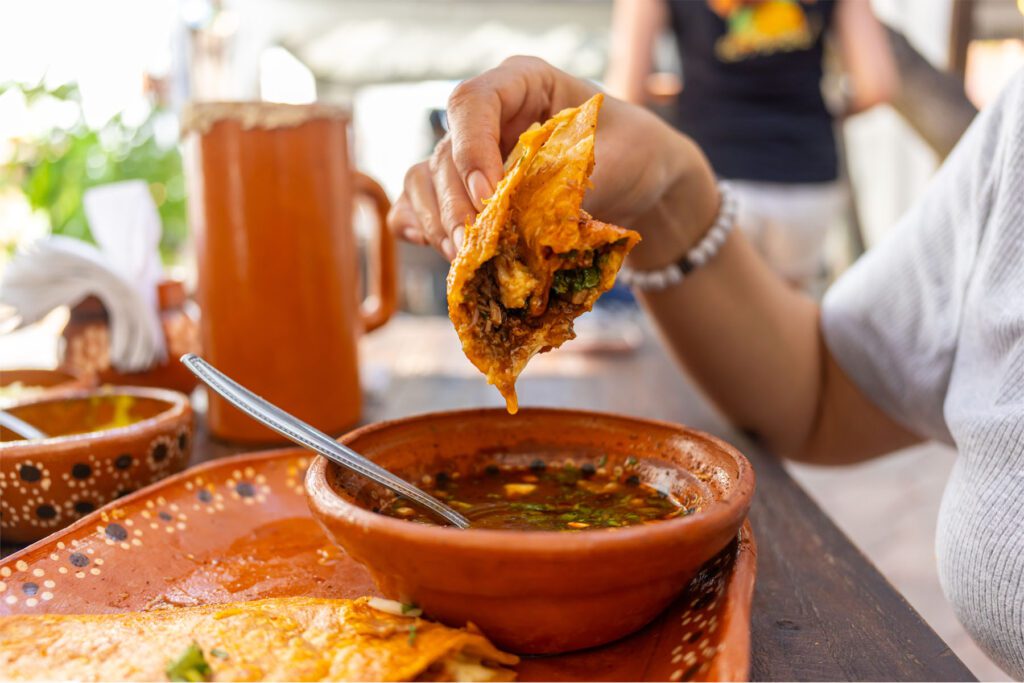

4. Mole Poblano
This emblematic dish hails from Puebla, a colonial-era city east of Mexico City known for its Baroque architecture and rich culinary heritage. Mole poblano is a complex sauce made with dried chillies, spices, seeds, nuts, and a hint of chocolate, served over turkey or chicken, first appearing in the city’s 17th century convent kitchens when Indigenous and Spanish ingredients were blended. While Puebla is still its spiritual home, the dish is prepared across Mexico for major celebrations, especially weddings and as part of 16th September’s Día de la Independencia (Independence Day) feasts.
5. Enchiladas and Enmoladas
Both are main dishes of tortillas rolled or folded around chicken, cheese, or beans, then topped with crumbled cheese, onions, and crema (a slightly tangy cultured cream) but their sauces are different. Enchiladas are covered in salsas – usually red or green from tomatoes, tomatillos, and chillies – while enmoladas are coated in rich mole. In Chihuahua, enchiladas are often stacked rather than rolled, with three to four layered up. In Oaxaca, enmoladas feature the state’s celebrated mole negro, made with local chillies and Oaxacan chocolate.
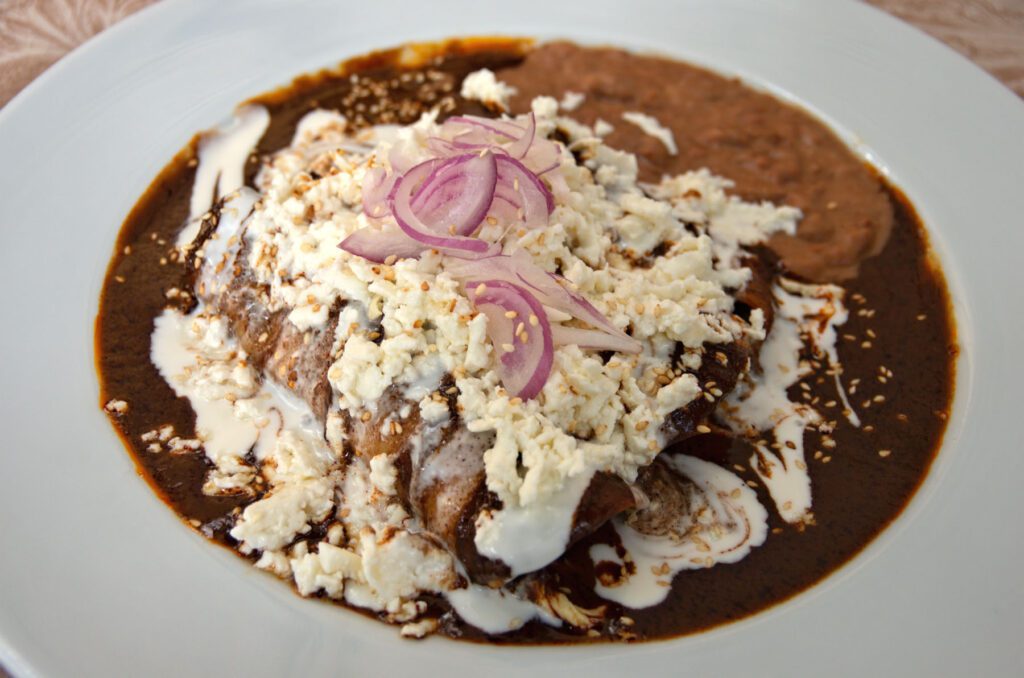

6. Chilaquiles
A breakfast and brunch staple, chilaquiles start with day-old tortillas cut into quarters, lightly fried, and simmered in salsa until softened. From there, the choice of toppings will determine how light or hearty the dish will be, with popular options including mole, a variety of red or green sauces, crumbly cheese, cream, fried eggs or shredded chicken.
7. Pozole
An Aztec-era soup-stew, pozole takes its name from ‘pozolli’ in the Indigenous Nahuatl language, meaning ‘foamy’ – a nod to the swollen hominy at its core. Today the hulled maize is simmered with pork or chicken, garlic and herbs, then finished with crispy garnishes like shredded lettuce or cabbage, radish, onion, oregano and lime. In Guerrero on the Pacific coast, you’ll find three classic styles: rojo (red chillies), verde (a green sauce with tomatillo and pumpkin seeds), and blanco (a pale broth). Specialist pozolerías serve the dish all year round, but it’s especially popular during Independence Day festivities.
8. Tamales
Dating back to the culinary traditions of the Aztec and Maya, tamales are Mexico’s original meal-to-go. Cooks spread masa (nixtamalised corn dough) onto corn husks or banana leaves, add a savoury or sweet filling (like chicken in green salsa, beans and cheese, or fruit with cinnamon) then fold and steam it until it’s set. Styles vary by region: in the Yucatán, tamales are often wrapped in banana leaves, while tamales colados are strained for an ultra-silky texture; i Michoacán, uchepos are tender fresh-corn tamales. They’re especially tied to 2 February’s Día de la Candelaria (Candlemas) holiday – a Catholic feast day where families get together for a meal of tamales and atole – a warm drink made from masa, water or milk, and flavoured with cinnamon or chocolate. You’ll find them nationwide, but keep an eye out for them in market comedores and bakeries.


9. Tlayudas
Oaxaca’s take on pizza is a slightly crisp large corn tortilla that’s brushed with asiento (unrefined pork lard) or beans, then topped with quesillo (Oaxacan string cheese), lettuce or cabbage, avocado and grilled meats like tasajo, cecina or chorizo, then cooked over charcoal. Eat it open-faced or folded and, for the most authentic experience, try it at the city’s Mercado 20 de Noviembre market or at one of many simple fondas (traditional casual eateries) found across the state.
10. Chile Relleno
Literally ‘stuffed chilli’, this colonial-era favourite – often credited to the convent cooks of Puebla – roasts and peels poblano chillies before stuffing them with cheese or a savoury picadillo (meat, fruit, spices), then batters, fries and serves them with a simple tomato sauce. While it’s usually plated up as a main served with rice and beans, regional variations are abound – in the north, Anaheim-type chillies sometimes stand in for poblanos while on the coast, seafood fillings can be found.
Taste your way through Mexico’s culinary highlights on our customisable 10-day Classic Mexico holiday, exploring iconic ruins, natural wonders and vibrant cities rich in food, art and history.
11. Chile en Nogada
Green, white and red to reflect the Mexican flag, this Puebla icon is attributed to the local Augustinian nuns who created it at the end of the War of Independence in 1821. The dish layers a roasted poblano stuffed with sweet-savoury picadillo, coats it in a fresh walnut cream (nogada), then scatters pomegranates and parsley over it.
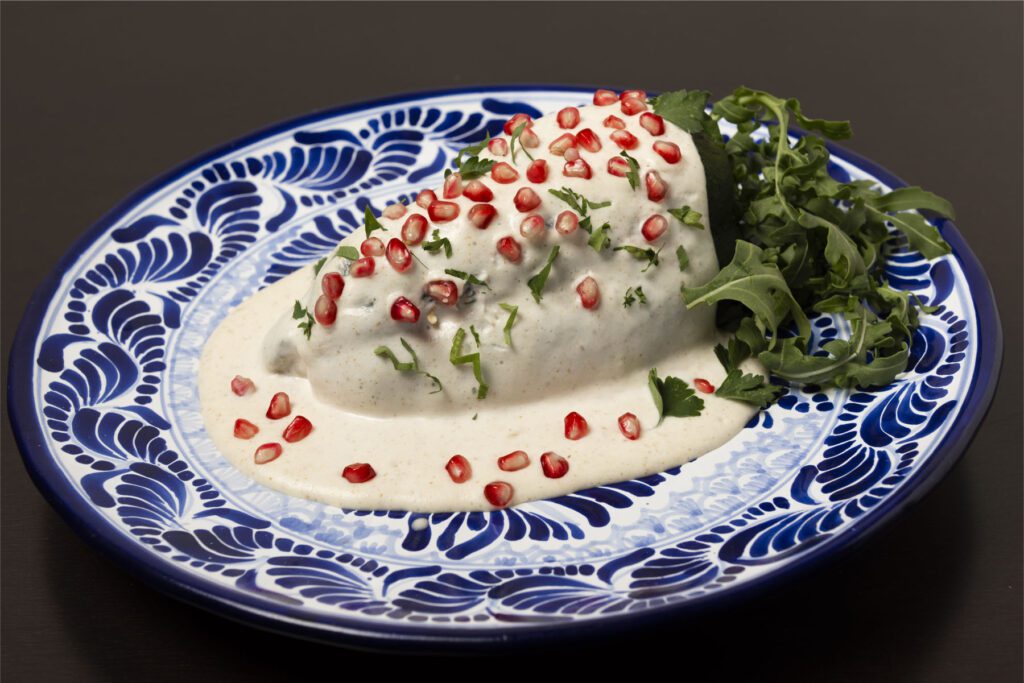

12. Elotes
Mexico recognises 64 maize varieties and elotes (grilled or boiled corn on the cob) draw on what’s in season: urban vendors might use white field corn for a juicy bite, while more rural stalls may go with heirloom types with chewier kernels. Typical toppings include mayonnaise or cream, crumbly cheese, chilli powder, and lime. A popular variation found in markets and plazas is esquites, where the corn kernels are shaved into a cup and served to go.
13. Dorilocos
An antojito (street snack) invented in Mexico City in the late 1990s, this sweet, salty, spicy, and sour combination is eaten straight from the bag. Dorilocos take a packet of nacho-flavoured tortilla chips (often Doritos, hence the name) and pile on toppings ranging from cucumber, jicama (Mexican turnip), carrot, and Japanese-style peanuts to tamarind sweets, sweet chilli sauce, chilli powder, and lime, with street vendors mixing and matching ingredients to create the flavours you want.
14. Sopes and Gorditas
Both these street-food classics start with a base of masa and cooked on a comal (griddle), but their shapes and serving styles differ. Sopes – thought to have originated in the Mexico’s central states – are small, thick discs with pinched edges, griddled until just firm, then topped with beans, meat, cheese, lettuce, cream, and salsa. Gorditas (‘little fat ones’) are thicker and split open to hold fillings like chicharrón (fried pork skin, sometimes stewed until tender), tinga (shredded meat simmered in tomato, onion, and chipotle), or cheese. Popular around the clock, you can eat them hot at street stalls, market fondas and casual eateries.
15. Quesadillas
These everyday street-food staples consist of folded tortillas – corn in most regions, but flour in the north – filled with cheese or other ingredients like huitlacoche (corn fungus, also called Mexican truffle), mushrooms, tinga, or zucchini flowers, then cooked on a comal. Keep in mind though, in Mexico City, a quesadilla may not automatically contain cheese unless you ask for it. Served with salsa and crema, they’re usually cooked to order and eaten fresh.
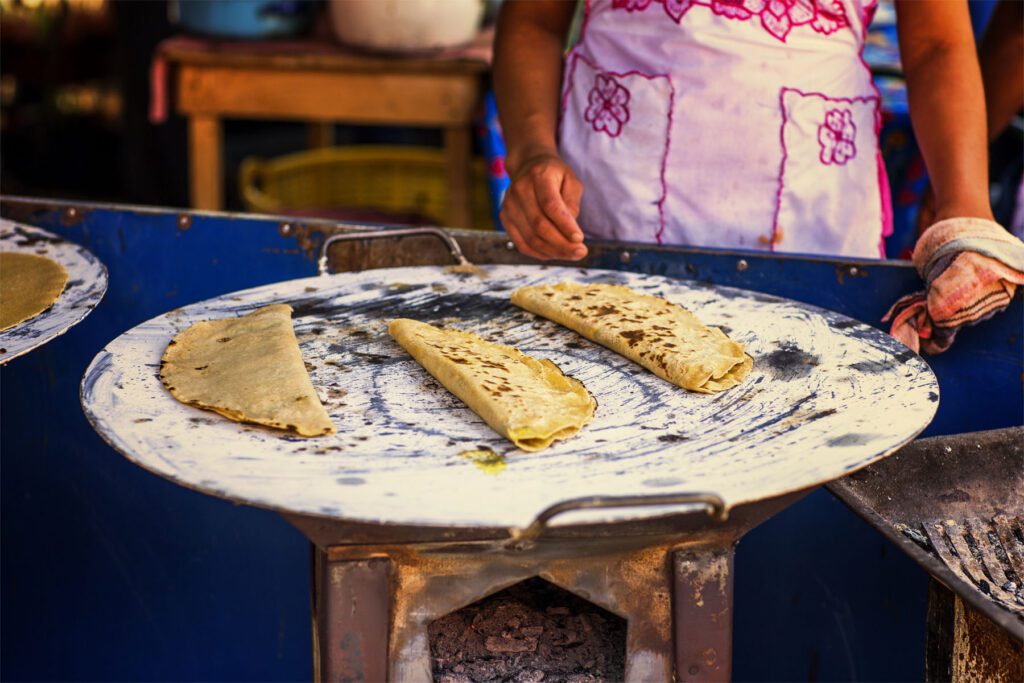

16. Huaraches
Originating in Mexico City in the 1930s and found today in market stalls, casual eateries, and neighbourhood street stands, this filling dish takes its name from the sandal-like shape of its masa base – ‘huarache’ means sandal in Spanish – which is topped with a layer of refried beans, then meat, cheese, lettuce, salsa, and crema. It’s griddled on a comal, so the masa stays crisp on the outside and soft inside.
17. Tlacoyos and Machetes
Dating back to the pre-Hispanic era, tlacoyos are oval-shaped blue-corn masa patties stuffed with beans, cheese, or fava beans, then cooked on a comal and topped with nopales (cooked cactus), salsa, and cheese. By contrast, machetes are a modern Mexico City street food named for the long blade they look like – thin tortillas up to 60cm long folded around cheese, meats, or vegetables, then griddled. Both are eaten hot and fresh, often as a quick meal on the go, and are especially popular around Mexico City.
18. Tostadas and Flautas
Both street-eats found nationwide in markets and casual eateries, these are popular for their crunchy texture and adaptable fillings, although their shapes differ. Tostadas are crispy, flat tortillas topped with beans, shredded meat or seafood, lettuce, salsa, crema, and cheese. They’re eaten nationwide and often used for ceviche or seafood toppings along the coast. Meanwhile flautas (literally ‘flutes’) are tightly rolled tortillas – usually filled with chicken, beef, or potatoes – fried until crispy, then served with lettuce, salsa, crema, and cheese.
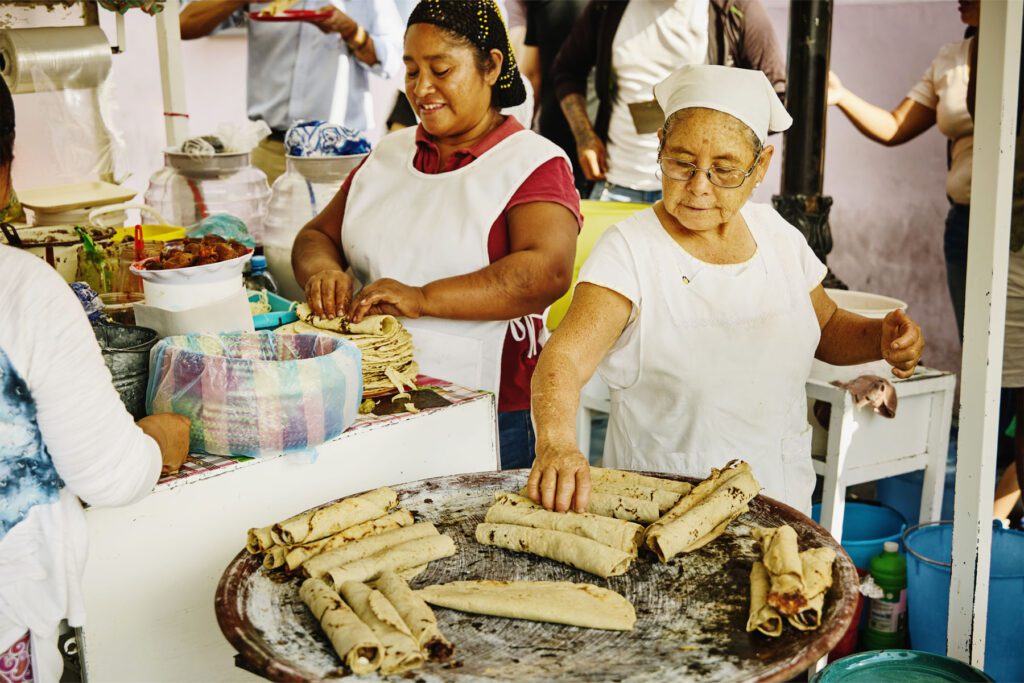

19. Sopa de Lima
A Yucatán specialty found everywhere from Mérida’s markets to family-run fondas, this light chicken soup is flavoured with the juice and zest of the local lima agria – a small, slightly bitter lime native to the region. The clear broth is simmered with chicken, garlic, onion, and capsicum, then topped with crispy tortilla strips, coriander, and sometimes avocado. The result is zingy and aromatic, with the citrus bringing a distinctive tang.
20. Aztec Soup
Also called sopa Azteca or tortilla soup, this central Mexican classic blends a tomato-chilli base with fried tortilla strips, creating a dish that’s both hearty and deeply rooted in Indigenous cooking traditions. The broth is typically enriched with pasilla chillies, garlic, and onion, and sometimes chicken is added. Garnishes like avocado, queso fresco, crema, and fresh coriander are served at the table, so you can customise the flavours as you eat.
Our fully customisable 10-day Authentic Mexico adventure takes you from Mexico City to Cancun – and to all the most iconic cities, ancient must-sees and foodie hotspots in between.
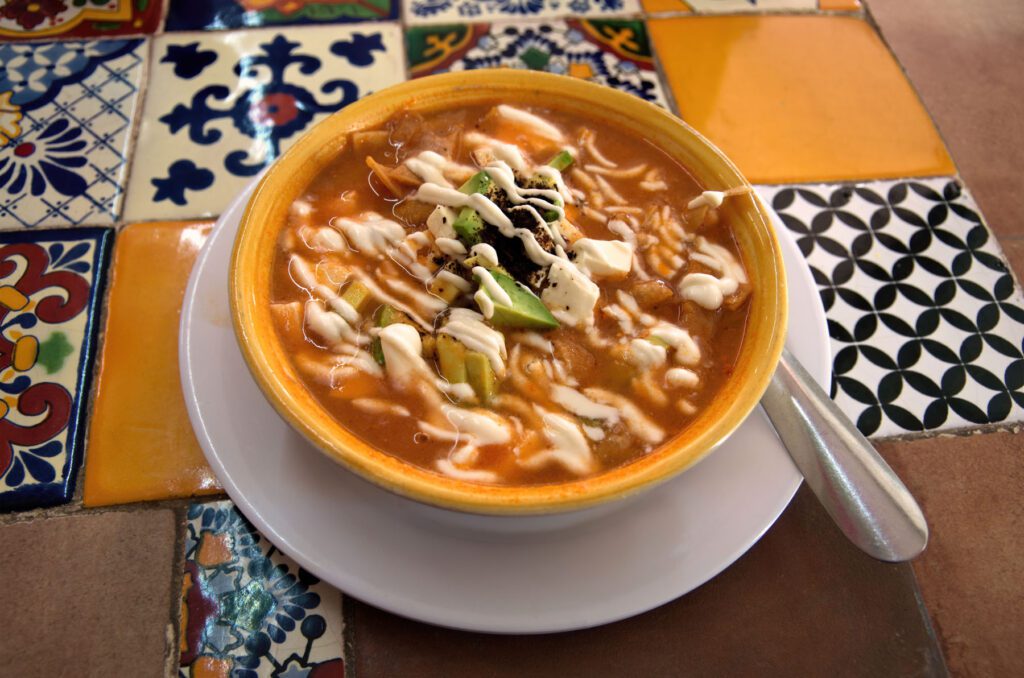

21. Papas con Valentina
This street snack is as simple as it is moreish: freshly fried or boiled potato chunks topped with Valentina – Jalisco’s tangy, moderately spicy chilli sauce. The kind of potato will vary depending on where and when you visit, as Mexico grows more than 4,000 types of native spuds. Commonly found in markets and plazas, especially in northern and central cities, they might be finished with lime juice or a sprinkle of chilli powder for bonus kick, then served in paper cones to go.
22. Huitlacoche
Prized as a delicacy across Mexico and sometimes called the ‘Mexican truffle’, huitlacoche is a corn fungus (Ustilago maydis) that infects the kernels, swelling them into soft, grey-black clusters. Its earthy, mushroom flavour is used to add depth to quesadillas, tamales, soups, and sauces. Eaten in Mesoamerican cultures for centuries, today it’s sold fresh in markets during the rainy season or preserved in jars and tins year-round.
23. Churros
Brought over from Spain in the 16th century, churros claimed their place as a prized Mexican dessert during the colonial era. They’re made from wheat flour dough piped into long ridged strips, fried until crisp outside and soft inside, then rolled in cinnamon sugar. Popular at street stalls and in cafés, they’re often served with thick hot chocolate for dipping, or filled with cajeta (goat’s milk caramel), chocolate, or vanilla cream.
24. Arroz con Leche
This creamy rice pudding is made by simmering rice with milk – usually fresh cow’s milk, though some recipes use sweetened condensed milk for richness – plus sugar, cinnamon, and sometimes raisins. Served warm or chilled, it’s a popular dessert across Mexico. Though Spanish in origin, it’s been adapted regionally, with some cooks adding vanilla or citrus zest.
25. Mezcal
Distilled from the heart of the agave plant and most famously made in Oaxaca, mezcal has been produced in Mexico for centuries, tracing back to Indigenous civilisations like the Zapotecs and Mixtecs, who fermented agave into ceremonial drinks. Spanish distillation techniques later refined the process, and today, while it’s served across the country – from rural cantinas to the legendary bars around Mexico City’s Centro Histórico – mezcal still holds ceremonial importance in villages, where it’s poured as an offering to the earth during planting and harvest festivals. Traditionally sipped neat from a small clay cup, it’s often accompanied by orange slices dusted with sal de gusano – a mix of salt, dried chilli, and ground agave worms.
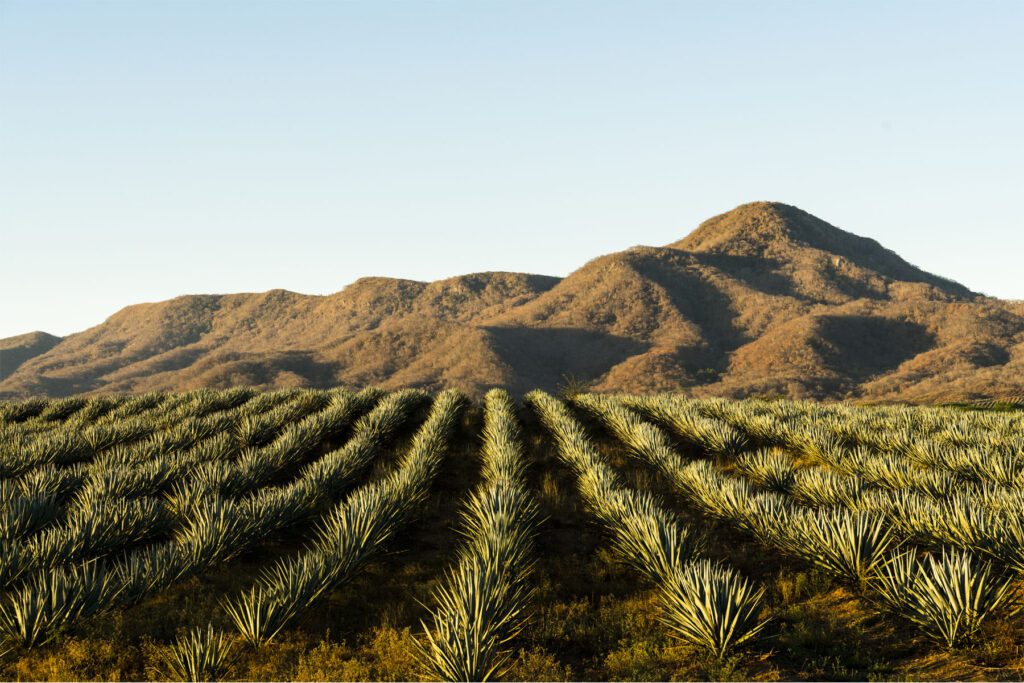

26. Tequila
This type of mezcal is made exclusively from the Blue Weber Agave (Agave tequilana). The agave heart is baked, crushed, fermented, and double-distilled, and it may be bottled immediately as blanco (unaged) or aged in oak barrels to become reposado (rested), añejo (aged), or extra añejo (extra aged). Tequila’s roots lie in Indigenous agave fermentation, with distillation introduced by the Spanish in the 16th century. While purists sip it neat, it also stars in traditional cocktails like the margarita.
27. Atole
This warm, thick drink is made by simmering masa with water or cow’s milk – traditionally fresh, though in some recipes sweetened condensed milk adds richness – and flavouring it with cinnamon, vanilla, piloncillo (unrefined cane sugar), or chocolate. Atole’s history stretches back to pre-Columbian civilisations, where it featured in Zapotec and Aztec meals. Today, it’s a staple at breakfast stalls and festive gatherings, especially during Día de los Muertos (2 November’s Day of the Dead, celebrated across Mexico to honour ancestors) and Día de la Candelaria.
28. Aguas Frescas
Sold by the jug across Mexico, these non-alcoholic drinks are made by blending sweetened water with fruits, seeds, flowers, or herbs. Popular varieties include horchata (a rice-based drink with cinnamon, sometimes milk), jamaica (a tart infusion of dried hibiscus flowers), and tamarindo (a sweet-sour tamarind beverage).
29. Oaxaca Hot Chocolate
Oaxaca is renowned for its artisanal chocolate, made by grinding locally sourced roasted cacao beans with sugar, cinnamon, and sometimes almonds into a coarse paste. This style preserves the cacao’s natural bitterness, balanced with spice and sweetness, making for a drink that’s richer and more textured than the hot chocolates you’re probably used to. Combined with hot milk or water, it’s best enjoyed at breakfast with pan de yema (a rich, eggy sweet bread).
30. Pulque and Tepache
Pulque is a mildly alcoholic beverage made by fermenting the sap (aguamiel) of the maguey agave. Consumed for at least 1,500 years – particularly by central Mexican cultures like the Aztecs – it was once reserved for priests, nobility, and ritual offerings to deities during agricultural ceremonies. Today, it’s still served in traditional pulquerías, with a tangy, yeasty flavour often enhanced with fruits or herbs. Tepache, by contrast, is a lightly fermented drink made from pineapple rinds simmered with piloncillo and spices, then left to ferment briefly. Naturally low in alcohol and subtly sweet, it’s chilled and sold in markets and at fiestas.
With so many attractions to explore, Mexico offers countless rewarding ways to work up and appetite – so consider our story, 10 Reasons Why You Should Visit Mexico, a moreish appetiser.
Final Tips for Food Lovers Visiting Mexico
With everything from labyrinthine markets to lauded fine-diners like Quintonil and Pujol standing by to satisfy your every craving, you certainly won’t go hungry in Mexico. And whether you time your trip to coincide with local festivals or to explore the country’s various attractions at another time, tucking into Mexican dishes in their natural habitat is an immersion in the cultural vibrance, community spirit, and living traditions that define its very heart. Plus, Adventure World’s MAKE TRAVEL MATTER® Experiences add yet another layer of multisensory connection – our curated foodie encounters give back to the community while revealing the country’s iconic flavours, from tasting chapulines and moles in Oaxaca’s famous food halls, to sipping mezcal at the source, clinking glasses in Mérida’s historic cantinas, and more. In any case, when you’re deciding what to eat in Mexico, think beyond this list and let your curiosity lead the way. Do that, and you’ll get a true taste of what Señor Bourdain was describing – food that’s not simple, not easy, but centuries old and deliciously refined.
